Question
Which of the following statements is/ are true regarding
W? Study the following information carefully to answer the given questions: There are nine persons i.e. P, Q, R, S, T, U, V, W and X who lives in a building having Three floors such that ground floor is numbered as 1 and above it is 2 and so on up to top floor numbered as 3. Each of the floors consist of 3 flats as flat-1, flat-2 and flat-3. Flat-1 of floor-2 is immediately above flat-1 of floor-1 and immediately below flat-1 of floor-3 and in the same way flat-2 of floor-2 is immediately above flat-2 of floor-1 and immediately below flat-2 of floor-3 and so on. Flat-2 is in east of flat-1 and flat-3 is in east of flat-2.Each of them likes different colours i.e. Red, Yellow, White, Black, Blue, Pink, Green, Grey and Orange. Note: If P lives above (or below) Q, then there are living in same flat unless stated otherwise. Number of Flats towards west of T is equal to the number of flats towards east of V, but in different floors. X who likes Green lives to the immediate west of R who likes Yellow and lives in Flat-3 of Floor-1. U does not live on Floor-2 but lives to the East of the one who likes Red who does not live in an even numbered flat. T and P lives in the same flat which is Flat-3. Q lives northwest of S. The one who likes Pink doesn’t live in topmost floor. The one who likes Blue colour and S lives in the same flat. W does not like Red and lives one of the extreme west flat. The one who likes Orange lives to the immediate west of the one who likes Grey and T likes White. Persons like OSolution
X who likes Green lives to the immediate west of R who likes Yellow and lives in Flat-3 of Floor-1. T and P lives in the same flat which is Flat-3. Note: Here we get one more case. 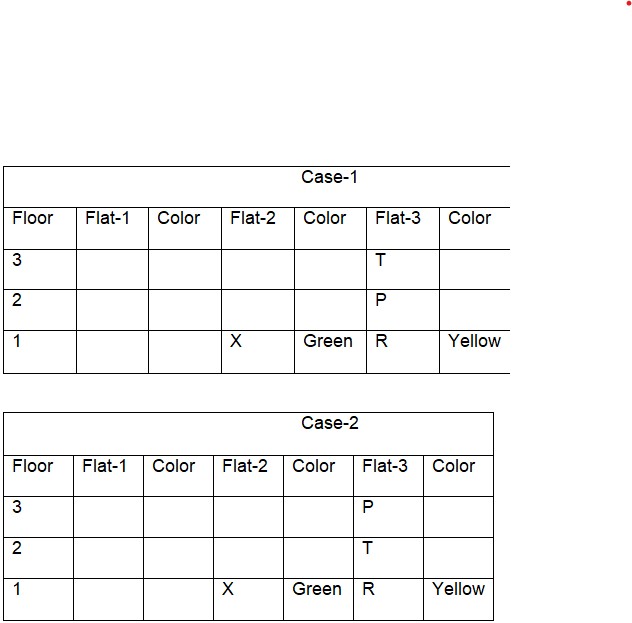 Number of Flats towards west of T is equal to the number of flats towards east of V, but in different floors. Note: Here we get one more possibility from each case. Thus 4 we have total cases
Number of Flats towards west of T is equal to the number of flats towards east of V, but in different floors. Note: Here we get one more possibility from each case. Thus 4 we have total cases 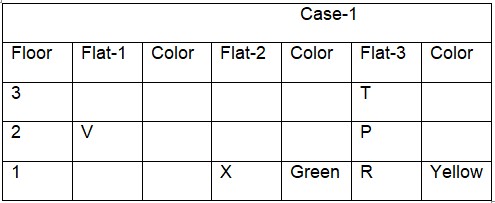
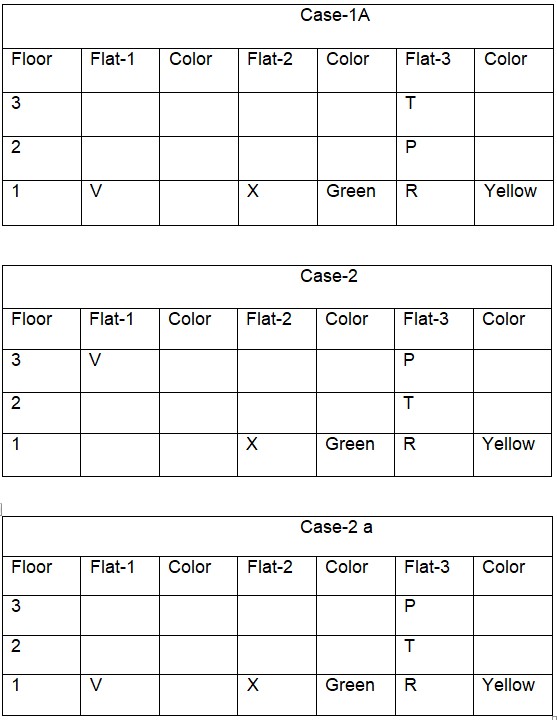 U does not live on Floor-2 but lives to the East of the one who likes Red who does not live in an even numbered flat. W does not like Red and lives one of the extreme west flat. Note: U must live on Flat-2 of Floor-3 (only possibility in all cases). Also we get only possibility for W in each case, except case-2
U does not live on Floor-2 but lives to the East of the one who likes Red who does not live in an even numbered flat. W does not like Red and lives one of the extreme west flat. Note: U must live on Flat-2 of Floor-3 (only possibility in all cases). Also we get only possibility for W in each case, except case-2 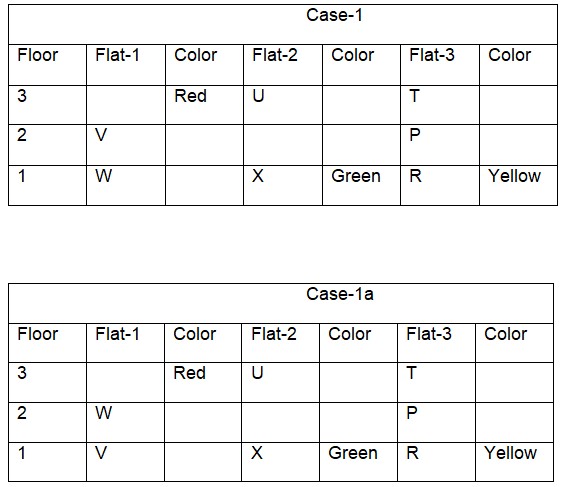
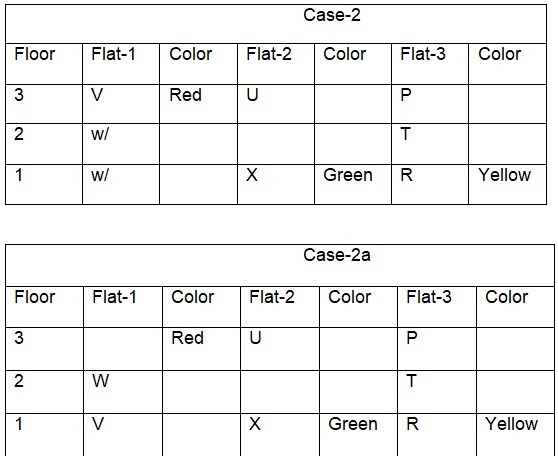 The one who likes Blue colour and S lives in the same flat. Q lives northwest of S Note: Case-2 gets rejected since Q lives northwest of S is not possible.
The one who likes Blue colour and S lives in the same flat. Q lives northwest of S Note: Case-2 gets rejected since Q lives northwest of S is not possible. 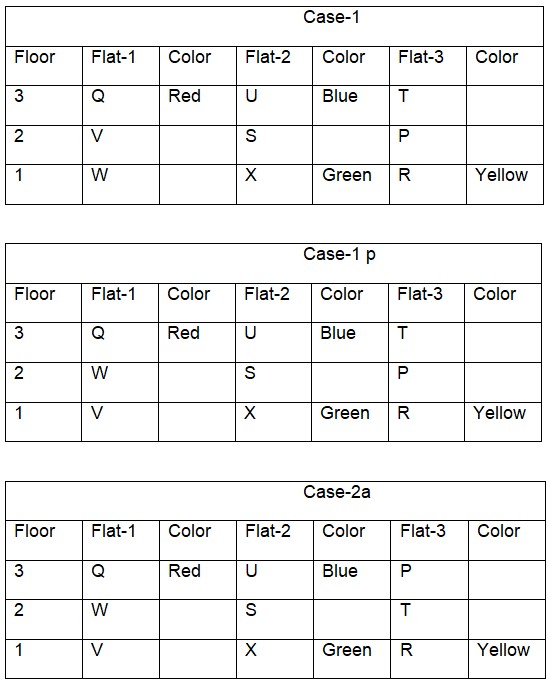 The one who likes Orange lives to the immediate west of the one who likes Grey and T likes White. Persons like Orange colour and Black colour lives in the same flat and W does not like Black colour. The one who likes Pink doesn’t live in topmost floor Note: T likes White as given. Finally P likes Pink in case-1-a Case-1 gets rejected since W doesn’t like Black Case-2-a gets rejected since the one who likes Pink doesn’t live in topmost floor Final arrangement
The one who likes Orange lives to the immediate west of the one who likes Grey and T likes White. Persons like Orange colour and Black colour lives in the same flat and W does not like Black colour. The one who likes Pink doesn’t live in topmost floor Note: T likes White as given. Finally P likes Pink in case-1-a Case-1 gets rejected since W doesn’t like Black Case-2-a gets rejected since the one who likes Pink doesn’t live in topmost floor Final arrangement 
20% of 1500 – 75% of 200 = 125% of ?
24% of 150% of 500 + 140 = ? × 8
458.32 - 563.32 + 659.32 =?
What will come in the place of question mark (?) in the given expression?
(√1089 + 84 ÷ 2) % of 348 = 416 - ?
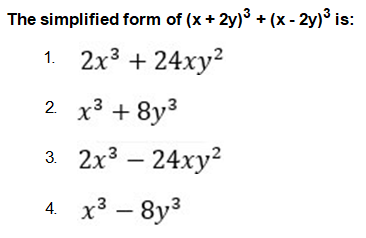
40% are the passing marks. A student gets 250 marks yet fails by 38 marks. What is the maximum marks?
(22.5 × 24) ÷ 40 + 51.50 = ? ÷ 5.25
36×?² + (25% of 208 +13) = 60% of 2400 + 17×18
What will come in the place of question mark (?) in the given expression?
√64 X 9 ÷ 3 + 12 X 3 = ? + 36(3/7) x 868 + 25% of 240 = (? + 65)
Relevant for Exams:


